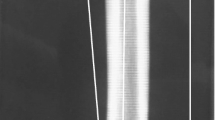Abstract
Objective
The objective was to determine the morphometric parameters of the head and neck of femur in Indians and to discuss its clinical application.
Materials and methods
The study comprised 50 dry femora which were obtained from the osteology section of the anatomy laboratory. The femoral head diameter, superior and inferior head lengths, anteroposterior and superoinferior diameters of the neck, superior and inferior neck lengths were measured with the digital vernier caliper. The data were morphometrically analyzed and sidewise comparison was done.
Results
The mean femoral head diameter was 41.5 ± 2.8 mm, superior and inferior head lengths were 30.8 ± 3.6 and 21.2 ± 3 mm, respectively. The mean superior length, inferior length, anteroposterior diameter and superoinferior diameter of the femoral neck were 22.5 ± 3.1, 31.2 ± 4.1, 23.9 ± 2.9, and 30.2 ± 2.5 mm, respectively. The statistically significant difference was not observed between the right and left sides comparison (P > 0.05).
Conclusions
The study has determined the morphometry of the head and neck of femur from Indian population. Since the implantation surgery relies on anatomical measurements, the present study was undertaken with reference to clinical application. We believe that the data obtained are enlightening not only for the orthopedicians, also important to the anthropologists.

Similar content being viewed by others
References
Leung K, Procter P, Robioneck B, Behrens K (1996) Geometric mismatch of the gamma nail to the Chinese femur. Clin Orthop 323:42–48
Siwach RC, Dahiya S (2003) Anthropometric study of proximal femur geometry and its clinical application. Indian J Orthop 37:247–251
Irdesel J, Ari I (2006) The proximal femoral morphometry of Turkish women on radiographs. Eur J Anat 10:21–26
Hoaglund FT, Low WD (1980) Anatomy of the femora neck and head, with comparative data from Caucasians and Hong Kong Chinese. Clin Orthop 152:10–16
Harty M (1957) The calcar femorale and the femoral neck. J Bone Joint Surg Am 39:625–630
Lofgren L (1956) Some anthropometric anatomical measurements of the femurs of Finns from the viewpoint of surgery. Acta Chir Scand 110:477–484
De Sousa E, Fernandes RMP, Mathias MB, Rodrigues MR, Ambram AJ, Babinski MA (2010) Morphometric study of the proximal femur extremity in Brazilians. Int J Morphol 28:835–840
Silva VJ, Oda JY, Santanna DMG (2003) Anatomical aspects of the proximal femur of adult Brazilians. Int J Morphol 21:303–308
Igbigbi PS (2003) Collodiaphyseal angle of the femur in East African subjects. Clin Anat 16:416–419
Igbigbi PS, Msamati BC (2002) The femoral collodiaphyseal angle in Malawian adults. Am J Orthop 31:682–685
Mourao AL, Vasconcellos H (2001) Geometria do femur proximal em ossos de brasileiros. Acta Fisiatr 8:113–119
Michelotti J, Clark J (1999) Femoral neck length and hip fracture risk. J Bone Miner Res 14:1714–1720
Karlsson KM, Sernbo I, Obrant KJ, Redlund-Johnell I, Johnell O (1996) Femoral neck geometry and radiographic signs of osteoporosis as predictors of hip fracture. Bone 18:327–330
Chauhan R, Paul S, Dhaon BK (2002) Anatomical parameters of North Indian hip joints–cadaveric study. J Anat Soc India 51:39–42
Mishra AK, Chalise P, Singh RP, Shah RK (2009) The proximal femur—a second look at rational of implant design. Nepal Med Coll J 11:278–280
Reddy VS, Moorthy GVS, Reddy SG (1999) Do we need a special design of femoral component of total hip prosthesis in our patients? Ind J Orthop 33:282–284
Noble PC, Jerry W, Alexander JW et al (1988) The anatomical basis of femoral component design. Clin Orthop 235:148–165
Bartoska R (2009) Measurement of femoral head diameter: a clinical study. Acta Chir Orthop Traumatol Cech 76:133–136
El Najjar MY, McWilliams KR (1978) Forensic anthropology: the structure, morphology and variations of human bone and dentition. Charles C. Thomas, Springfield, Illinois
Ericksen MF (1979) Ageing changes in the medullary cavity of the proximal femur in American black and whites. Am J Phys Anthropol 51:563–569
Conflict of interest
All the authors declare that they have no competing interests. No funds were received in support of this study.
Author information
Authors and Affiliations
Corresponding author
Rights and permissions
About this article
Cite this article
Murlimanju, B.V., Prabhu, L.V., Pai, M.M. et al. Osteometric study of the upper end of femur and its clinical applications. Eur J Orthop Surg Traumatol 22, 227–230 (2012). https://doi.org/10.1007/s00590-011-0823-9
Received:
Accepted:
Published:
Issue Date:
DOI: https://doi.org/10.1007/s00590-011-0823-9




